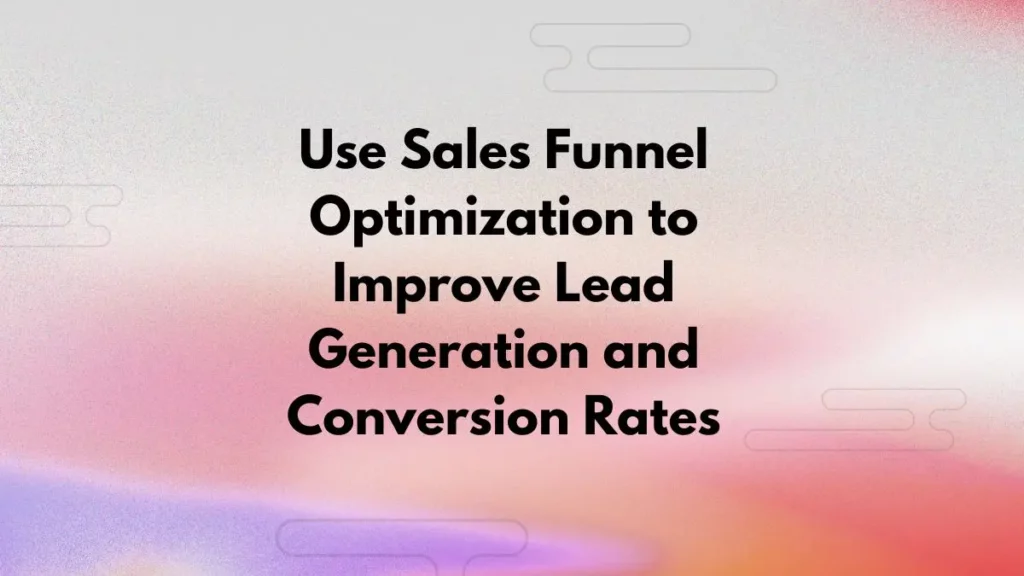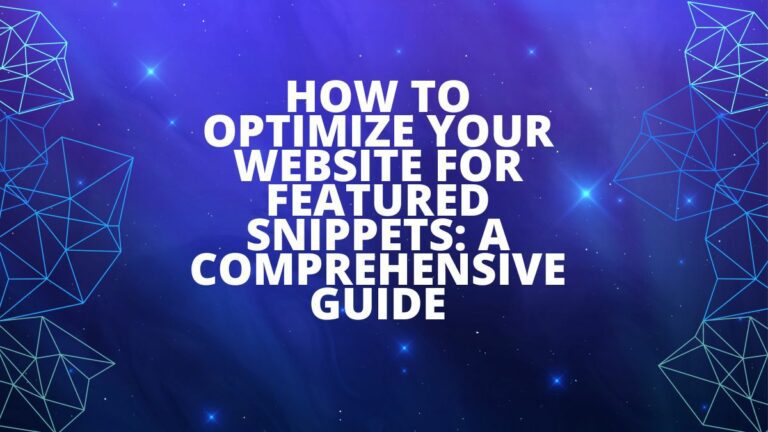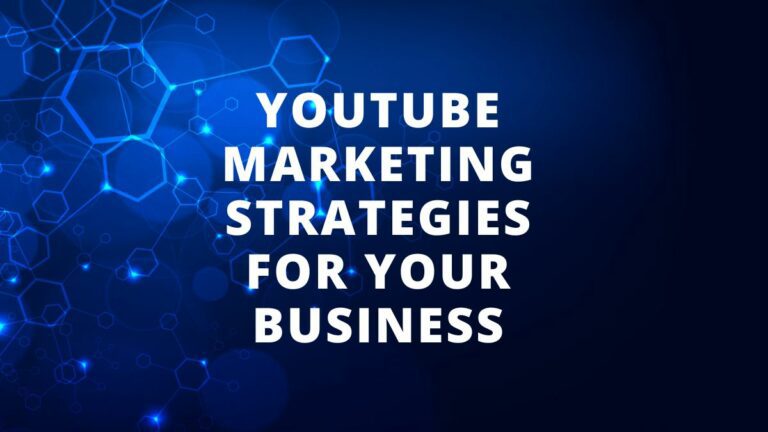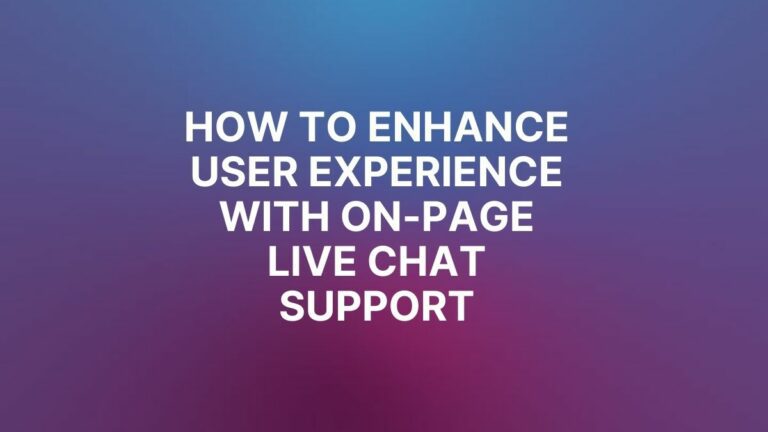
Use Sales Funnel Optimization to Improve Lead Generation and Conversion Rates
In the competitive online business landscape, mastering the art of sales funnel optimization is essential for sustainable success. One effective strategy that can supercharge your results is sales funnel optimization. By carefully crafting and refining your sales funnel, you can attract more qualified leads and guide them seamlessly toward becoming loyal customers. This comprehensive guide will delve into sales funnel optimization, exploring proven strategies, techniques, and best practices to skyrocket your lead generation and conversion rates.
Understanding the Sales Funnel
At the core of any successful marketing campaign lies the sales funnel. It represents a potential customer’s journey from the initial point of contact to the final conversion. Therefore, understanding the various stages of the sales funnel is crucial for effective optimization.
Analyzing the Buyer’s Journey
To optimize your sales funnel effectively, it’s vital to understand the buyer’s journey—the path your potential customers take from first encountering your brand to making a purchase decision.
- Awareness Stage: Customers identify a need or problem during the awareness stage and search for a solution. Therefore, capturing their attention and providing valuable information is critical
- Consideration Stage: In the consideration stage, customers evaluate different options and weigh their pros and cons. You aim to position your offering as the best solution and build trust
- Decision Stage: The decision stage is when customers are ready to purchase. It would help if you focused on removing doubts or objections and providing a seamless conversion experience
Identifying Target Audience
You must define and understand your target audience to optimize your sales funnel effectively. Then, knowing their needs, preferences, and pain points, you can tailor your marketing efforts to resonate with them.

Defining Your Target Audience
Clearly defining your target audience involves identifying demographic information, psychographic traits, and their specific challenges or desires.
Conducting Market Research
Market research helps you gain valuable insights into your target audience’s behavior, preferences, and purchasing habits. Analyze market trends, conduct surveys, and study your competitors to gather valuable data.
Creating Buyer Personas
Buyer personas are fictional representations of your ideal customers. You can better align your marketing messages with their needs by creating detailed profiles encompassing demographics, interests, and motivations.
Crafting an Effective Lead Magnet
A compelling lead magnet is valuable content or resource you offer your potential customers in exchange for their contact information. It is an irresistible incentive to capture leads and initiate the nurturing process.
Importance of Lead Magnets
Lead magnets are a powerful tool to attract and build relationships with your target audience. They provide value upfront and position you as an authority in your industry.
- Types of Lead Magnets: Various types of lead magnets can effectively capture your audience’s attention. Some popular options include:
- eBooks: eBooks offer in-depth knowledge and insights on a specific topic. They provide comprehensive value and allow you to showcase your expertise
- Webinars: Webinars are live or recorded online presentations that provide educational content and engage your audience. They offer real-time interaction and allow you to establish yourself as a thought leader
- Templates and Tools: Providing templates, checklists, or tools relevant to your target audience’s needs can be highly effective. These resources help streamline processes and provide practical solutions, making them highly enticing to potential leads
Driving Traffic to Your Sales Funnel
You need to drive quality traffic to your sales funnel to optimize your lead generation efforts. This requires a well-planned and executed marketing strategy that leverages various channels and tactics.
Leveraging Content Marketing: Content marketing is a powerful approach to attracting and engaging your target audience. Creating valuable, informative, and shareable content can establish credibility, increase brand visibility, and drive traffic to your sales funnel.
Search Engine Optimization (SEO) Strategies: Implementing effective SEO techniques ensures your website ranks higher in search engine results pages, making it more visible to potential customers. Focus on optimizing keywords, creating quality backlinks, and providing valuable content.
Social Media Marketing: Social media platforms offer vast opportunities to connect with your target audience. Develop a solid social media presence, share engaging content, and leverage targeted advertising to drive traffic and generate leads.
Optimizing Landing Pages
Landing pages play a critical role in converting visitors into leads. Optimizing these pages helps maximize conversion rates and ensures a seamless user experience.
Designing Compelling Landing Pages
A well-designed landing page captures attention, communicates your value proposition, and encourages visitors to take action. Use persuasive copy, appealing visuals, and clear call-to-action (CTA) buttons to guide visitors toward conversion.
A/B Testing and Conversion Rate Optimization (CRO)
Implement A/B testing to compare different landing page versions and identify the elements that generate the highest conversion rates. Optimize headlines, CTA placement, form fields, and other factors to improve performance continually.
Capturing Visitor Information Effectively
The lead capture form on your landing page is crucial for gathering visitor information. Keep it concise, ask for essential details, and offer an incentive to encourage form completion.

Implementing Email Marketing Campaigns
Email marketing remains one of the most effective ways to nurture leads and guide them through the sales funnel. Implementing targeted email campaigns helps build relationships, establish trust, and drive conversions.
- Building a Subscriber List: Create opportunities for visitors to subscribe to your email list by placing opt-in forms strategically on your website and landing pages. Offer exclusive content or discounts as incentives to encourage sign-ups
- Personalization and Segmentation: Segment your email list based on demographics, interests, or engagement levels to deliver personalized content that resonates with each segment. Then, tailor your messages to address their specific needs and pain points
- Automation and Drip Campaigns: Automation allows you to send timely and relevant emails based on predetermined triggers or actions. Set up drip campaigns that deliver targeted messages to nurture leads and guide them toward conversion
Nurturing Leads with Drip Campaigns
Nurturing leads through drip campaigns helps maintain engagement and move prospects closer to making a purchase. In addition, you can increase the likelihood of conversion by providing valuable content and staying top-of-mind.
- Importance of Lead Nurturing: Lead nurturing builds trust, establishes your expertise, and keeps your brand in front of potential customers. It allows you to address their concerns, educate them about your offerings, and guide them through the buyer’s journey
- Drip Campaign Strategies: Craft a series of emails that provide educational content, helpful tips, case studies, or customer success stories. Then, gradually introduce promotional offers or incentives to encourage conversions while maintaining a value-driven approach
- Welcome Series: A welcome series is the first set of emails sent to new subscribers. Use this opportunity to introduce your brand and provide a warm welcome. Share relevant resources, set expectations, and invite them to engage with your brand
- Educational Content: Deliver informative content that educates and addresses common pain points or challenges your target audience faces. This positions your brand as a valuable resource and builds trust over time
- Promotional Offers: Introduce exclusive promotions, discounts, or limited-time offers to entice leads to take the next step in the buying process. Create a sense of urgency and communicate the benefits of acting promptly
Utilizing Effective Call-to-Actions (CTAs)
A well-crafted call-to-action (CTA) prompts your audience to take a specific action, such as purchasing, subscribing to a newsletter, or downloading a resource. Therefore, optimizing your CTAs is crucial for maximizing conversions.
Crafting Persuasive CTAs
Use action-oriented language and create a sense of urgency in your CTAs. Communicate the value and benefits of taking the desired action, enticing your audience to act immediately.
Placement and Design Considerations
Strategically position CTAs throughout your website, landing pages, and emails to ensure they are easily visible and accessible. Make them visually appealing with contrasting colors and compelling design.
Split Testing for Optimal Results
Perform A/B tests on different versions of your CTAs to determine which variations yield higher conversion rates. Test different wording, colors, sizes, and placements to optimize your CTAs continually.
Implementing Live Chat and Chatbots
Enhancing customer engagement and providing real-time support is crucial for guiding potential customers through the sales funnel. Live chat and chatbots offer efficient and effective solutions.

Enhancing Customer Engagement
Live chat enables immediate interaction with your website visitors, answering their questions and providing personalized assistance. It improves customer experience and builds trust.
Benefits of Live Chat and Chatbots
Live chat and chatbots are available 24/7, ensuring instant support and information. They streamline communication, provide quick responses, and free up resources by automating repetitive tasks.
Choosing the Right Platform
Select a live chat or chatbot platform that aligns with your business needs and integrates seamlessly with your website. Consider factors such as customization options, analytics, and ease of use.
Leveraging Social Proof
Social proof is vital in establishing credibility and trust in today’s digital age. You can influence potential leads and drive conversions by showcasing positive experiences and feedback from satisfied customers.
Types of Social Proof
Utilize various forms of social proof to build trust and credibility:
Testimonials
Display testimonials from satisfied customers highlighting their favorable experiences with your product or service. Include their name, photo, and relevant details to add authenticity.
Case Studies
Present case studies that showcase real-life examples of how your offering helped solve specific problems or achieve desired outcomes. Provide measurable results and demonstrate your expertise.
User-Generated Content
Encourage customers to share their experiences and feedback through user-generated content such as reviews, ratings, or social media posts. This authentic content builds trust and fosters a sense of community.
Implementing Retargeting Strategies
Retargeting allows you to reach out to potential customers who have previously shown interest in your brand. By presenting personalized ads and messages, you can re-engage them and increase conversion rates.
Analyzing Metrics and Key Performance Indicators (KPIs)
Tracking and analyzing relevant metrics and key performance indicators (KPIs) is crucial to gauge the success of your sales funnel optimization efforts.
Identifying Relevant Metrics and KPIs: Determine the metrics and KPIs that align with your business goals and sales funnel objectives. These may include conversion rates, click-through rates, bounce rates, average order value, and customer lifetime value.
Tools for Tracking and Analysis: Utilize analytics tools such as Google Analytics or other marketing automation platforms to track and analyze the performance of your sales funnel. These tools provide valuable insights into user behavior and help identify areas for improvement.
Making Data-Driven Decisions: Leverage the data you collect to make informed decisions and adjustments to your sales funnel optimization strategies. Use A/B testing, conduct experiments, and iterate based on the insights gained from the data.

Integrating CRM and Marketing Automation
To streamline lead management and optimize your sales funnel, it’s essential to integrate customer relationship management (CRM) systems and marketing automation tools.
- Benefits of CRM and Marketing Automation: CRM systems and marketing automation tools help centralize customer data, automate repetitive tasks, and provide valuable insights. In addition, they enable personalized communication, effective lead nurturing, and streamlined sales processes
- Selecting the Right Tools: Choose CRM and marketing automation tools that align with your business needs and integrate seamlessly with your existing systems. Consider scalability, ease of use, reporting capabilities, and integration options
- Streamlining Lead Management: Utilize CRM systems to track and manage leads throughout the entire sales process. Automate lead nurturing, assign tasks, and create workflows to ensure timely follow-ups and effective communication
Implementing Personalization Techniques
Personalization is a powerful strategy to enhance the customer experience and drive conversions. You can significantly improve engagement and conversions by tailoring your messaging, content, and recommendations to each individual’s preferences.
Customizing User Experiences
Deliver personalized experiences based on user behavior, demographics, or previous interactions. Personalize website content, product recommendations, and email campaigns to create a sense of individualized attention.
Dynamic Content and Recommendations
Utilize dynamic content that adapts based on user preferences or past interactions. For example, display personalized product recommendations, content blocks, or special offers that align with the user’s interests and needs.
Behavioral Tracking and Segmentation
Track user behavior throughout the sales funnel and segment your audience based on their actions and preferences. Then, leverage this data to deliver targeted messages and offers that resonate with each segment.
Streamlining the Conversion Process
To increase conversion rates, it’s essential to streamline the conversion process and remove any obstacles or friction that might hinder potential customers from completing their purchases.
- Simplifying the Checkout Process: Optimize your checkout process by eliminating unnecessary steps or form fields. Implement a guest checkout option, offer multiple payment options, and ensure a smooth and secure experience
- Reducing Friction and Barriers: Identify and address any potential barriers or objections that might deter customers from completing their purchases. For example, offer transparent pricing, provide precise product information, and include trust signals such as security badges or customer reviews
- Addressing Objections and Concerns: Anticipate common objections or concerns potential customers may have and address them proactively. For example, provide FAQs, live chat support, or customer testimonials to alleviate doubts and build trust
Tracking and Analyzing Customer Feedback
Collecting and analyzing customer feedback is crucial for understanding their needs, preferences, and pain points. By actively listening to your customers, you can make data-driven improvements to your sales funnel.
- Collecting Customer Feedback: Implement feedback mechanisms such as surveys, reviews, or feedback forms to gather insights directly from your customers. Encourage open and honest feedback to uncover valuable information
- Feedback Channels and Tools: Utilize various channels to collect customer feedback, including email surveys, social media listening, or dedicated feedback platforms. Leverage tools such as survey software or sentiment analysis tools to streamline the process
- Using Feedback to Optimize the Sales Funnel: Analyze customer feedback to identify areas for improvement within your sales funnel. Use the insights gained to refine your messaging, address pain points, and enhance the overall customer experience

Closing Notes
Leveraging the data from loyalty programs enables businesses to make informed marketing decisions and predict customer behavior. Companies can foster long-term brand loyalty and advocacy by building emotional connections and continuously nurturing customer relationships.
While challenges may arise, addressing customer loyalty program fatigue, data privacy concerns, and handling complaints with care can help overcome obstacles. In addition, staying informed about innovations and trends in loyalty programs allows businesses to adapt and incorporate new technologies that enhance the customer experience.
Digital Results would be happy to help you with your digital marketing needs. Get in touch for a free 30-minute consultation—one of our experts will walk through how we can help optimize your search engine optimization (SEO).
Ready to Grow Your Search Engine Results?
Let Digital Results assist you in your SEO strategy and help
deliver the search engine results you need.





